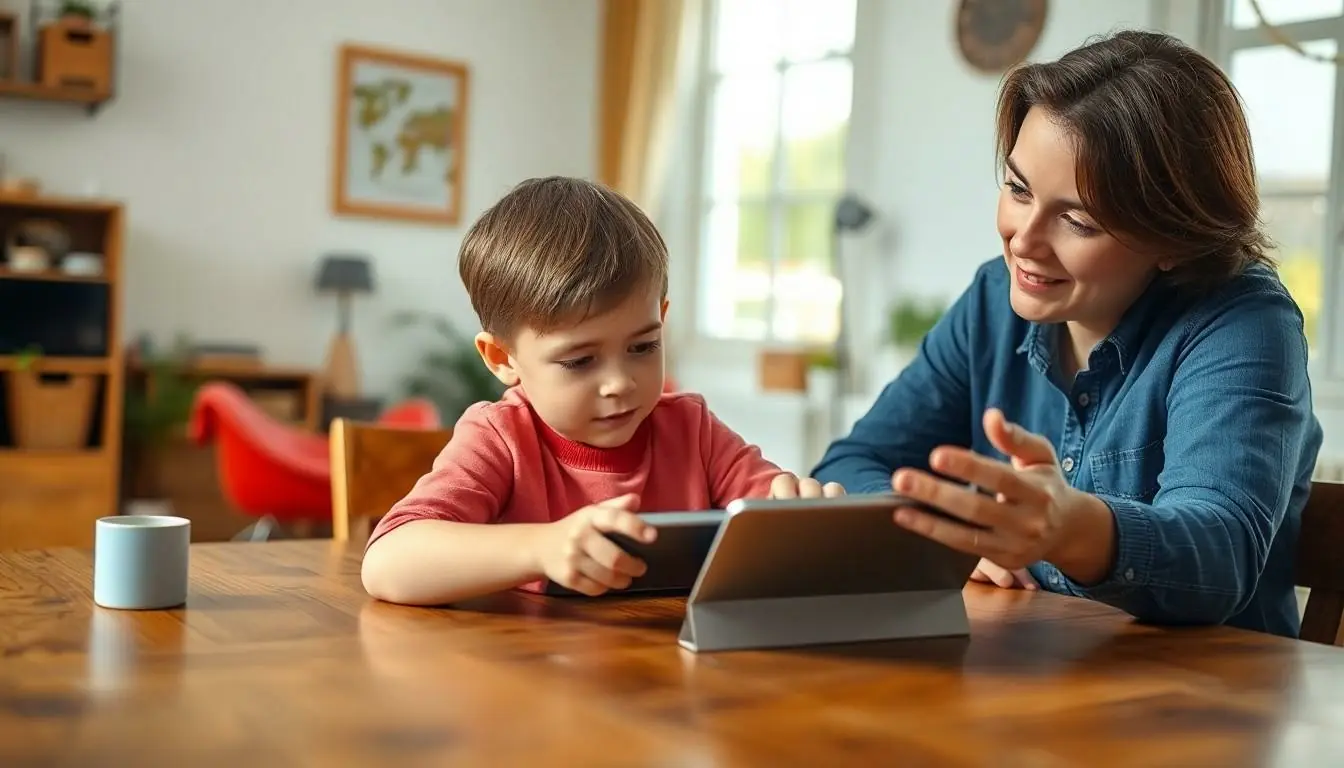Table of Contents
ToggleNavigating screen time for a child with ADHD can feel like trying to herd cats—chaotic and unpredictable. With screens everywhere, from tablets to TVs, parents often wonder how much is too much. The struggle is real, but finding the right balance is crucial for a child’s well-being and development.
Understanding ADHD and Screen Time
Managing screen time for children with ADHD requires a nuanced approach due to its unique challenges. Striking a balance between screen exposure and other activities is essential for their overall development.
The Impact of Screen Time on Children with ADHD
Research indicates excessive screen time negatively affects attention spans in children with ADHD. Challenges such as increased impulsivity and difficulty with focus often arise from high engagement with electronic devices. Real-life experiences show that some children may become irritable after prolonged screen exposure. In contrast, moderate screen use can aid learning in certain contexts, promoting educational content. Understanding these effects helps parents set appropriate boundaries.
Recommended Screen Time Guidelines
Experts recommend limiting screen time to 1 hour per day for children ages 2 to 5. For those aged 6 and older, balancing leisure activities, including screen time, with physical activity, is vital. Engaging in non-screen interactions enhances social skills and emotional well-being. Setting consistent routines for usage can foster a healthier relationship with screens. Parents might consider co-viewing as a strategy to enhance understanding and moderation.
Factors Influencing Screen Time
Understanding the factors that influence screen time for children with ADHD proves crucial for effective management. Parents can identify several key considerations to optimize screen use.
Age and Developmental Stage
Age significantly affects how children interact with screens. Preschoolers, aged 2 to 5, benefit from limited screen time, ideally no more than 1 hour per day. This age group requires opportunities for physical play and social interactions to support their development. School-aged children, aged 6 and older, can manage more flexible screen time but also require balance with physical activity and other leisure pursuits. Parents should tailor screen content to match developmental stages, focusing on age-appropriate, educational materials that can enhance learning and engagement rather than hinder attention.
Severity of ADHD Symptoms
The severity of ADHD symptoms determines how effectively children can handle screen time. Children with more intense symptoms might struggle with impulse control, making it critical to restrict screen exposure to prevent overstimulation. Reducing screen time could help alleviate issues like irritability and distraction. For children with milder symptoms, additional screen time may not have the same negative consequences. However, monitoring reactions during and after screen use remains essential for all children. Tracking each child’s response to screen content provides valuable insights for parents to adjust their strategies accordingly.
Positive Aspects of Screen Time
Moderate screen time offers distinct advantages for children with ADHD when managed appropriately. Various aspects warrant attention.
Educational Benefits
Screen time can enhance learning opportunities for children with ADHD. Interactive educational apps engage learners and can improve focus. For instance, cognitive games stimulate problem-solving skills and enhance attention spans. Additionally, educational videos enrich understanding of various subjects. Using screens for educational content can complement traditional teaching methods, making learning more appealing. Structured lessons through digital tools may aid in retention of information. The key lies in choosing high-quality educational materials that encourage active participation.
Social Interaction and Entertainment
Engaging with screen content can serve as a vehicle for social interaction. Multiplayer games enable children to connect with peers, fostering team-building skills. These shared experiences facilitate conversations and collaboration among friends. Similarly, educational platforms often include forums for discussion, promoting social engagement. Screens provide entertainment options as well, offering relaxation and joy. Lively shows and interactive storytelling spark creativity and imagination. Balancing entertainment with educational experiences enriches children’s lives, making screen time a valuable resource when monitored effectively.
Negative Aspects of Screen Time
Screen time can negatively affect children with ADHD in several critical ways. Understanding these challenges helps parents manage their child’s usage more effectively.
Attention Span and Focus
Prolonged screen exposure diminishes attention spans in children with ADHD. Children often find it hard to concentrate on tasks when transitioning from screens to real-world activities. Rapid scene changes in videos may lead to increased impulsivity. Focus on educational content can mitigate this risk, but excessive recreational use often overwhelms attention capabilities. Research suggests limiting screen time promotes better engagement in non-digital tasks, supporting overall cognitive development.
Sleep Disruption and Behavioral Issues
Screens can disrupt sleep patterns in children with ADHD. Blue light emissions from devices interfere with melatonin production, making it harder for kids to fall asleep. Insufficient sleep can exacerbate behavioral issues, such as irritability and difficulty regulating emotions. Behavioral problems often escalate with increased screen time, leading to challenges in interactive settings. Consistent monitoring helps parents recognize these patterns, allowing for timely adjustments to screen habits that promote healthier sleep routines.
Strategies for Managing Screen Time
Managing screen time effectively involves setting clear guidelines and encouraging alternative activities. Focus on balance to nurture healthy habits.
Setting Boundaries and Limits
Establishing boundaries for screen time helps children with ADHD thrive. Experts recommend limiting daily use to one hour for children aged 2 to 5. Older children can engage in screens for more extended periods, provided it’s balanced with physical play and offline activities. Create specific times for screen use to promote a structured routine. Encourage children to take breaks every 20 to 30 minutes to prevent overstimulation. Consistent rules help children understand expectations regarding screens. Parents should monitor content and discuss it with their children to ensure it aligns with educational goals.
Alternative Activities and Engagement
Encouraging alternative activities fosters balance in children’s lives. Promote physical activities, such as sports or outdoor play, to support overall well-being. Engage children in creative pursuits like arts and crafts, which stimulate imagination without screens. Board games and puzzles offer opportunities for social interaction, enhancing their interpersonal skills. Reading books together can improve language development and comprehension. Consider scheduling family game nights to encourage connection and fun away from screens. By diversifying activities, children develop essential skills while maintaining a healthy relationship with technology.
Conclusion
Finding the right balance in screen time for children with ADHD is crucial for their overall development. By setting clear boundaries and promoting alternative activities, parents can help their children thrive in both the digital and real worlds. Engaging with educational content can enhance learning while minimizing the risks associated with excessive screen exposure. Regular monitoring and open discussions about screen use foster a healthier relationship with technology. Ultimately, a thoughtful approach to screen time can support children’s emotional well-being and social skills, paving the way for a brighter future.









